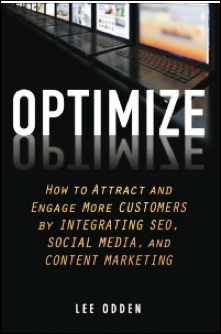 When you think of content optimization, what's the first thing that comes to mind?
When you think of content optimization, what's the first thing that comes to mind?
Do you think of keywords, links and search engines?
Or do you focus on useful content, interesting articles, engaged audiences and happy customers?
If you're in the second camp, you're clearly familiar with “the big picture” of optimization. But if you're in the first camp, then stick around—sounds like you need a new perspective!
The most important thing we learned from the Google Panda updates in 2011 is that search engines are really serious about improving search quality and user experience.
Since then, the priority for site owners has been to create original, interesting and sharable content that attracts links from other sites.
Lee Odden has written his first book titled, Optimize: How to Engage More Customers by Integrating SEO, Social Media and Content Marketing. In the book, he takes a holistic approach to content and search optimization and proposes that companies should consider all of the digital assets, data and content they have to work with in order to make both customers and search engines happy.
Here's what you need to know about the book.
Author's Purpose

Lee Odden would like to change the conversation about what optimization means and help companies realize that a customer-centric approach to content that engages and inspires action is more profitable than fussing over keywords and links.
His objective is that marketers, PR professionals, small- to medium-sized business owners and large company marketing executives will think more about how to meet their target audiences' needs with content they truly care about.
What to Expect
At 223 pages, the book is divided into three Phases.

In Phase 1, you will learn about the changing nature of consumer preferences and behaviors in terms of search, social media and content, and what that means for your online marketing strategy.
In Phase 2, you will learn some “optimized content marketing tactics,” such as content planning, measurement and developing buyer personas into topics.
Get World-Class Marketing Training — All Year Long!
Are you facing doubt, uncertainty, or overwhelm? The Social Media Marketing Society can help.
Each month, you’ll receive training from trusted marketing experts, covering everything from AI to organic social marketing. When you join, you’ll also get immediate access to:
- A library of 100+ marketing trainings
- A community of like-minded marketers
- Monthly online community meetups
- Relevant news and trends updates
Phase 3 is all about scaling. You will be introduced to the processes and training needed to grow and maintain an integrated social media, SEO and content marketing program in your organization.
Favorite Chapters
Chapter 1: Setting the Stage for an Optimized State of Mind
In this chapter, the author poses a profoundly important question: “Are you optimizing for search engines and rankings or for customers and sales?”
No doubt you've had this experience: You're searching on Google or Bing, and you come across a page that is clearly “optimized” for SEO. This page has a high rank in SERP but when you click through, the actual content doesn't do much for your overall experience.
When you see these pages, just remember that it is becoming increasingly important to optimize content for customer and user experiences, rather than for search engines. Here are some good tips to guide you:
- Use words that matter most to your customers in titles, links and body copy in order to inspire your readers to take action.
- Text used in titles should make it easy for readers to understand the topic of the page in the first few words.
- Text used to link from one page to another should give readers a good idea what they'll find on the destination page.
- A consistent approach to titling, labeling and copy in your web pages, image captions, video descriptions and links will create more confidence for the reader and inspire sales.
These tips will help you to create an experience that is more relevant to your customers and at the same time produce content that is search engine–friendly. But if you focus only on keywords, links and search engines, you stand the chance of alienating your customers with content that lacks creativity and inspiration.
Chapter 4: In It to Win It—Setting Objectives
Before a business decides what content to optimize and socialize (or even how to do it), they must ask another essential marketing question: “What are we trying to do?” The answer should be obvious: “We're trying to get more people to buy what we're selling.”

This is the general objective for all companies across the board. But when it comes to practical online marketing objectives, these will be unique to each company's situation. Some companies want to increase their number of customers, others want to focus more on revenue and profitability, and still others want to emphasize customer retention.
These are all great objectives and from a search, social media and content perspective, being able to tie them to overall organizational goals is essential.
Establishing your marketing goals starts with a good understanding of your current business performance. So an online marketing program that leverages content, SEO and social media will include key performance indicators such as:

Discover Proven Marketing Strategies and Tips
Want to go even deeper with your marketing? Check out the Social Media Marketing Podcast! Publishing weekly since 2012, the Social Media Marketing Podcast helps you navigate the constantly changing marketing jungle, with expert interviews from marketing pros.
But don’t let the name fool you. This show is about a lot more than just social media marketing. With over 600 episodes and millions of downloads each year, this show has been a trusted source for marketers for well over a decade.
- Search visibility
- Social mentions
- Web page links
- Citations in online media and blogs
- Social shares
- Social links
- Visitors to company website
- Visitors to company social networks
- Newsletter subscribers
- Blog and social content subscribers, fans, friends and followers
- Comments and other measures of engagement
Measurable marketing outcomes typically include:
- Number of downloads
- Webinar or other online event participation
- Inquiries
- Leads
- Sales
- Referrals
- Brand advocacy
In a nutshell, the simplest thing to do is evaluate your online marketing strategy for what has worked so far and what needs improvement. To tie marketing goals to overall business goals, think about how well your site is performing currently and what the overall online business goals are for the future.
Chapter 9: Content Isn't King, It's the Kingdom—Creation vs. Curation
It's a good idea to mix curated content with original content. In fact, content curating is a great way to extend your own site, but only in addition to—not instead of—your original content.
Rule of thumb: Pure creation is demanding. Pure automation doesn't engage. Curating provides the best of both worlds. Here are some content curation tips.
Types of content to curate:
- Content created by influential people who are important to your target audience
- Statistics, research and reports
- Compelling or provocative industry news
- Videos—YouTube, Vimeo, Viddler
- SlideShare presentations
- White papers, ebooks and case studies
- Infographics and other data visualizations
- Tips, how-to's and best practices
- Aggregating the best comments from your own or others' blogs
Where to publish curated content:
- Company blogs
- Ebooks
- Email newsletters
- Social media channels
- Contributed articles (or guest posts) to industry sites
Sources of news to curate:
- Industry-specific newsletters
- Google Alerts, Google News or Google Reader
- Curation tools: Flipboard, Scoop.it, Storify
- News aggregators: Alltop, popurls, Techmeme
- Press release distribution services: PRWeb, PRNewswire, or Marketwire
Chapter 11: Social Network Development—Don't Be Late to the Networking Party
Lee Odden introduces Chapter 11 with yet another compelling question, “How long does it take to see any kind of ROI from a social media marketing campaign?”
Unfortunately the answer is a long time. Here's why. The time to start building a social network is not when you need it. The time to start is well beforehand, because it takes time to develop relationships. It takes time to listen, participate, create optimized content and understand the triggers that will inspire sales or referrals.

Many small businesses go after the most popular social sites with a “fish where the fish are” mentality. While that is not an unreasonable strategy in itself, it's important to know which specific social networks are relevant to your customers.
Because there are only a handful of social networks, chances are one or more will be relevant for your online marketing and there are many opportunities for brands on each network. Here are some of them.
Opportunities for brands on Facebook:
- Participate in one-to-one, one-to-many or many-to-many conversations
- Build connections and relationships with individuals
- Listen to what brand fans are interested in
- Create and cross-promote shareable content
- Offer promotions and special offers
- Interact with current and potential customers
Opportunities for brands on Google+:
- Google+ hangouts for B2B brands can be used for videoconferencing to answer questions, conduct training or offer creative pitches.
- Google+ allows you to upload a mix of updates, images and videos to relevant segments of your network.
- Because Google+ is integrated with Google search, the more people who add your brand to their circles, the greater the chance that you will appear in those users' Google search results.
Personal Impressions
This book scores very high on two points in particular. First is the author's interpretation and delivery of a very complete and holistic Internet marketing strategy that includes search, social media and content marketing. This is not a new approach, but Lee Odden delivers excellent insight, detail and practical application on the subject.
Second, I love the way he offers a fresh perspective on the conversation surrounding optimization, as well as his candid critique of the misguided approach to SEO that a lot of marketers have taken.
On the downside however, I've already come across several books that are very similar to Optimize. Here's an example. Many of these authors are peers and industry thought leaders who share parallel platforms and mindsets, so it's no surprise that their books start to sound a little similar too.
Having said that, you could probably learn everything you need to know about “the three kings” of online marketing—search, social and content—in this one book. Optimize is an excellent investment, especially if you haven't read other books with a similar approach.
Social Media Examiner gives this book a 4-star rating.
What do you think? Leave your questions and comments in the box below.
Images from iStockPhoto.
Attention Agency Owners, Brand Marketers, and Consultants

Introducing the Marketing Agency Show–our newest podcast designed to explore the struggles of agency marketers.
Join show host and agency owner, Brooke Sellas, as she interviews agency marketers and digs deep into their biggest challenges. Explore topics like navigating rough economic times, leveraging AI, service diversification, client acquisition, and much more.
Just pull up your favorite podcast app, search for Marketing Agency Show and start listening. Or click the button below for more information.

